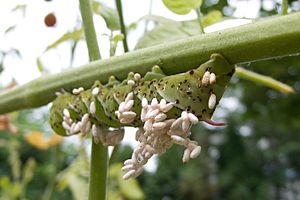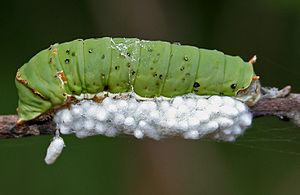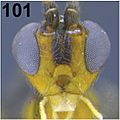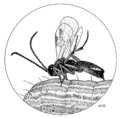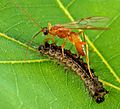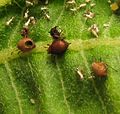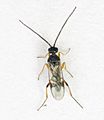Braconid facts for kids
Quick facts for kids Braconids |
|
|---|---|
 |
|
| The braconid Atanycolus. | |
| Scientific classification | |
| Kingdom: | |
| Phylum: | |
| Class: | |
| Order: | |
| Superfamily: | |
| Family: |
Braconidae
|
Braconids are a large family of wasps. They are known as parasitoid wasps. This means they lay their eggs on or inside other insects. The young wasps then grow by feeding on their host.
Braconids are one of the biggest insect families. There are between 50,000 and 150,000 different kinds of braconid wasps around the world. These many types are grouped into 45 smaller groups called subfamilies. They also belong to about 1,000 even smaller groups called genera.
Contents
How Braconid Wasps Use Hosts
Most braconid wasps are parasitoids. They live on or inside other insects. Their main targets are the young forms (called larvae) of beetles, flies, and butterflies or moths. They also target insects like aphids and true bugs.
Laying Eggs Inside Hosts
Many braconid species lay their eggs inside their host. These are called endoparasitoids. The wasp larvae grow inside the host. Most of the time, the host insect dies. Sometimes, the host becomes unable to have babies and less active.
Braconid wasps have special ways to help their young survive inside the host. They use tiny viruses that live inside them. These viruses are called polydnaviruses. The wasps inject these viruses into the host along with their eggs.
How Viruses Help Wasps
These polydnaviruses are very important. They weaken the host's immune system. This means the host cannot fight off the wasp larva growing inside it. The viruses act like a special chemical mix. They stop the host's body from recognizing the wasp larva as a threat.
Scientists believe this special relationship started about 100 million years ago. The DNA of the wasp actually contains parts that make these viral particles. Over time, these viruses have changed a lot. They now look different from any other known viruses. Because of this, each wasp species often has its own special virus. This virus works best on a specific host insect.
Other Types of Parasitism
Some braconid wasps also target adult insects. This happens especially with true bugs and beetles. A few types of braconids can even cause galls to form on plants. Galls are unusual growths on plants.
Images for kids
See also
 In Spanish: Bracónidos para niños
In Spanish: Bracónidos para niños


